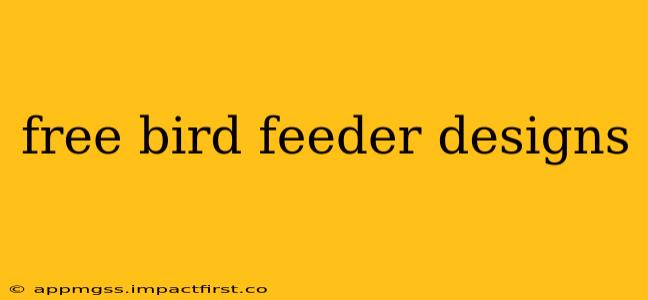Want to attract a vibrant array of birds to your backyard? Building your own bird feeder is a rewarding and cost-effective way to enjoy their company. This guide explores several free bird feeder designs, ranging from simple DIY projects to more intricate creations, all without breaking the bank. We'll even tackle some frequently asked questions to help you get started.
Simple and Easy Bird Feeder Designs
For beginners, several straightforward designs require minimal materials and crafting skills. These are perfect for a quick afternoon project and are ideal for introducing children to the joys of birdwatching.
-
Recycled Bottle Feeder: This is arguably the easiest design. Clean and thoroughly dry a plastic bottle (soda bottles work well). Cut two holes opposite each other near the top for perches (use small twigs or dowels). Cut a larger opening lower down for the birds to access the seed. Fill with birdseed and hang using string or wire. You can even decorate it for a personalized touch!
-
Milk Carton Feeder: Similar to the bottle feeder, a clean and dry milk carton offers another simple option. Cut an opening near the bottom and create perches as described above. You can even add a roof using cardboard or another recycled material to protect the seed from rain.
-
Pine Cone Feeder: This natural design is both beautiful and functional. Spread peanut butter (or a similar bird-safe paste) on a pine cone and roll it in birdseed. Hang it from a tree branch using string or twine. This feeder is great for smaller birds.
More Advanced Free Bird Feeder Designs
If you're feeling more ambitious, these designs offer more complex structures and aesthetic appeal:
-
PVC Pipe Feeder: Using readily available PVC pipes and connectors, you can create a durable and weather-resistant feeder. Cut the pipe to your desired length, add perches, and create a feeding area. This design can be easily customized to fit your needs and style.
-
Wooden Pallet Feeder: Repurpose old wooden pallets by carefully dismantling them and using the wood to build a more substantial feeder. This allows for creative designs and a rustic aesthetic. Remember to thoroughly sand and treat the wood to ensure it's safe for birds.
-
Wine Bottle Feeder: Clean and dry a wine bottle, drill feeding holes around the body of the bottle, and create a simple base for stability. This offers a unique and sophisticated look.
What kind of birdseed is best for a homemade feeder?
The best birdseed mix for your homemade feeder depends on the types of birds you hope to attract. A general mix containing sunflower seeds, nyjer seeds, and millet is a good starting point. However, research the local bird species in your area to determine their preferred foods. Some birds prefer specific types of seeds or nuts.
How do I keep squirrels away from my homemade bird feeder?
Squirrels are notorious for raiding bird feeders. To deter them, consider these strategies:
- Use squirrel-resistant feeders: Some feeders are specifically designed with baffles or cages to prevent squirrels from reaching the seed.
- Hang feeders in difficult-to-reach locations: This might involve suspending them from a long wire or placing them in areas where squirrels have limited access.
- Use slippery perches: Applying a thin layer of petroleum jelly or Vaseline to the perches can make it difficult for squirrels to grip. However, ensure it's bird-safe.
How often should I refill my homemade bird feeder?
The frequency of refilling depends on the size of your feeder, the number of birds visiting, and the type of seed. As a general rule, aim to refill it when it's about half empty to ensure a consistent supply of food for your feathered friends. Regularly cleaning the feeder will also prevent the spread of disease.
What materials are safe to use for a bird feeder?
When creating your bird feeder, always prioritize the safety of the birds. Avoid using treated lumber, toxic paints, or harmful chemicals. Natural materials like wood (untreated), recycled plastic, and metal are generally safe options. Always ensure that any materials used are thoroughly cleaned and free from any harmful substances.
By following these simple guidelines and choosing from the many free bird feeder designs available, you can create a welcoming habitat for birds and enjoy hours of birdwatching pleasure. Remember, the most important aspect is to have fun and enjoy the process!
